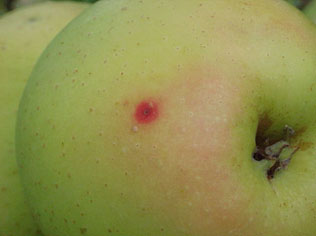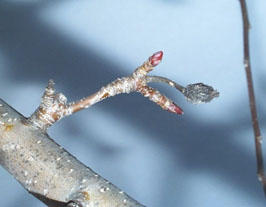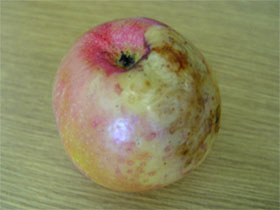Address any questions or comments regarding this newsletter to the individual authors listed after each article or to its editors, Nathan Johanning, 618-939-3434, njohann@illinois.edu or Bronwyn Aly 618-695-6060, baly@illinois.edu. The Illinois Fruit and Vegetable News is available on the web at: http://ipm.illinois.edu/ifvn/. To receive or be removed from email notification of new postings of this newsletter, contact Nathan Johanning or Bronwyn Aly at the phone numbers or email addresses above.
In This Issue:
Upcoming Programs (listings for beginning and established growers)
Regional Reports (north central, southern Illinois)
Vegetable Production and Pest Management (To Spray or Not to Spray? Late Season Crop Protection in Pumpkins)
Fruit Production and Pest Management (Two articles on Bitter Rot in Apples)
Upcoming Programs
Check the Illinois SARE calendar for a full list of programs and links for registration.
http://illinoissare.org/ and http://illinoissare.org/calendar.php
Also see the University of Illinois Extension Local Food Systems and Small Farms Team's website at:
http://web.extension.illinois.edu/smallfarm/ and the calendar of events at http://web.extension.illinois.edu/units/calendar.cfm?UnitID=629.
- Meet the Farmers, Meet the Buyer. Monday, October 10, 2016 10:00 AM to 5:00 PM (Doors open at 9:30 AM). St. Louis University campus in the II Monastero Building, 3050 Olive Street, St. Louis, Missouri This event is an opportunity for farmers to meet with buyers and learn what it takes to do business with the grocery and foodservice industries. To register visit http://www.ilfb.org/ifb-news-and-events/conferences-events/october-10,-2016-meet-the-buyer-event.aspx. For more information contact Cynthia Haskins, 309-557-2155; CHaskins@ilfb.org.
- Organic Soil-borne Disease Management Webinar. October 13, 2016 from Noon – 1pm. Contact Laurie George (ljgeorge@illinois.edu) or James Theuri (jtheu50@illinois.edu ). Preregistration required: https://web.extension.illinois.edu/registration/?RegistrationID=14944
- Illinois Specialty Crops, Agritourism, and Organics Conference, January 11-13, 2017. Crown Plaza, Springfield, IL. For more information, Illinois Specialty Growers Association, 1701 Towanda Ave., Bloomington, IL 61701. Phone 309/557-2107 FAX 309/557-3729 E-mail Cblary@ilfb.org.
- Ohio State University 2016 Direct Marketing Webinar Series. Noon (Eastern time). Take this opportunity to learn more about marketing issues. Recordings of all webinars can be found at www.go.osu.edu/DirectMarketingWebinars. Links below are for recording for previous webinars and connection links for future sessions.
- Feb. 18 Marketing Trends Learned from the Super Bowl -- Eric Barrett & Rob Leeds
- Mar. 2 Using All Your Senses in Branding Your Business -- Eric Barrett & Rob Leeds
- Apr. 21 Enhancing Your Web Presence -- Melissa Carter
- May 26 Product Recall & Traceability -- Eric Pawlowski
- June 16 Product Labeling -- Emily Adams
- July 21 Celebrate Ohio Local Foods Week -- Heather Neikirk & Patricia Barker
- Aug. 18 Produce Auctions http://carmenconnect.osu.edu/auctionsforproduce/ -- Brad Bergefurd
- Sept. 15 Pricing Your Products http://carmenconnect.osu.edu/pricingproducts/ -- Megan Leffew
- Oct. 20 Cooperatively Marketing Your Products http://carmenconnect.osu.edu/marketingyourproducts/ -- Hannah Scott
- Nov. 17 Using Facebook for Your Business http://carmenconnect.osu.edu/facebookforyourbusiness/ -- Duane Rigsby
- Dec. 15 Survey Results for Ohio Produce Marketers http://carmenconnect.osu.edu/surveyresultsformarketers/ -- Direct Marketing Team
Regional Reports
From north-central Illinois... For the most part, it feels like autumn. Our temperatures are on the high side, but pumpkins and gourdes abound as deciduous trees begin their shift to dormancy.
Rainfall has been plentiful with some room to dry in between. Fruit flies have been a nuisance. Last night I received an email with a photo of what looks like a dropped peach covered in parasitic wasps, Thyrateles procax. My guess is they were after the fruit fly larva in the fruit.
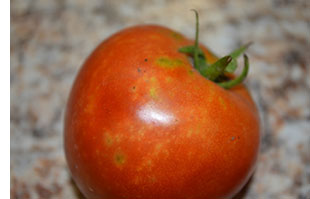
Stink bug damage on tomatoes. Photo: C. Enroth
Tomato hornworm (also known as tobacco hornworm) have popped up as a big problem on all things nightshade. Tomatoes, peppers, and ground cherries. Earlier this summer, yellow jacket wasps were taking care of my tomato pests. I enjoyed watching one yellow jacket clumsily carrying a small tomato hornworm to its doom. The change in the season seems to have changed the diet of the meat-eating wasps to all things sweet. It's so late in the season I'm not bothering anymore with Bt spray for the hornworms. Opting to spend the morning and evening scouting and picking. This may be the week I trash the summer crops, though I am holding out on some for some seed saving.
This morning I picked the last of my big beef tomatoes. I had to brush away several stink bugs from the tomatoes. Their damage is evident on several crops. Check out the following link for tables of various insecticides and their effectiveness against the adults of brown marmorated stink bug. http://extension.psu.edu/plants/tree-fruit/files/bmsb-slide-presentation
Chris Enroth (309-837-3939; cenroth@illinois.edu)
From southern Illinois ... This week so far has been pleasantly dry for a change. The weather this week has been very summer-like with lots of humidity and temperatures in the upper 80s to low 90s. Our last rainfall was last Friday into early Saturday morning with a system that dumped across parts of southern Illinois. Fortunately, it was not the 12+ inches that many areas saw in early August, but it was enough. Here in Murphysboro we had around 1.9"; however, at home at the farm in southern Monroe Co. we had 3.8". This made harvesting for those Saturday Markets a little damp, but certainly one of those things you just have to deal with from time to time.
In the orchard, we are still in the midst of apple harvest. Growers are just finishing up with Golden Delicious and are now into Red Delicious, Jonagold, and some early Fuji's among others. Overall, fruit flavor and taste is good; however bitter rot and other similar rots have plagued almost everyone with the excessive rainfall we have had this summer (see the two articles below for details on bitter rot and its management). Peaches are mostly finished up and most plasticulture strawberries are planted and starting to take off
Out in the field pumpkin, harvest continues and you can see pumpkins out at most farm markets and stores. From my assessment the pumpkin crop is average. There are some decent pumpkins out in most fields if you have kept on top of the insect and disease management. Bacterial spot, plectosporium blight, powdery mildew and downy mildew (in some places) have all been problematic. Phytopthora has been a problem in many low lying, poorly drained fields as well. Cucumber beetles and squash bugs have also been prevalent. Just from all of the rainfall, I have noticed additional fruit rot issues on some specialty pumpkins/winter squash; some having cracks or other wounds that have now turned into soft, rotten spots.
Now is the time to think about planting many of our winter annual cover crops. Crimson clover, hairy vetch, and annual ryegrass need to get in the ground soon for good establishment. We can wait a little later for things like cereal rye.
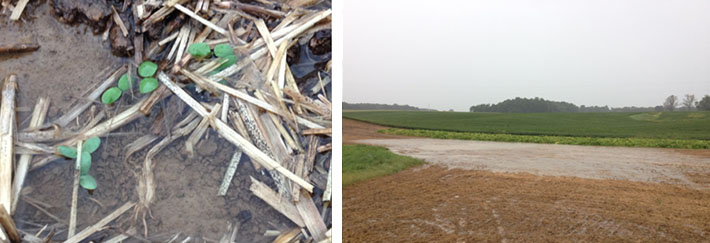
Newly emerged crimson clover just 4 days after planting (left). Water backing up into a block of pumpkins during last week’s rain (right); fortunately, this water all drained out a couple hours after the rain stopped. Taken in the midst of the 3.8" of rain that fell last Friday (9/16) in southern Monroe County. Photos: N. Johanning
Nathan Johanning (618-939-3434; njohann@illinois.edu)
Vegetable Production and Pest Management
To Spray or Not To Spray? Late Season Crop Protection in Pumpkins.
At this time of year, many times we ask ourselves whether or not we need to make an additional fungicide and/or insecticide sprays on pumpkins and other fall cucurbits. This being said I too am challenged with this debate and while I don't have a definitive answer, here are some things that I think about and consider.
- How healthy are the vines? Are there still actively growing plants that can still benefit from protection? At this point hopefully the answer is yes as the fruit harvested from an actively growing vine are the best quality and have the best shelf life. Remember that most of the fungicides we utilize are mainly preventative so our main goal is keeping what is healthy now, healthy in the future, not curing a disease outbreak that has already take over. Also, we want to prevent excessive powdery mildew infection especially on stems of fruit as that will cause the stem to shrivel after harvest, decreasing the marketability of the fruit.
- Are fruit still being set? Typically it takes around 30-40 days from bloom to mature fruit (depending on temperatures and variety) with decent weather so some of those fruit set last week or even a few this week could still make for some additional harvest by mid to late October which could help supply late season needs if we don't have an early frost (of course, as we head north in the state your frost date and cooler overall temperatures come into play as well).
- What is the weather forecast? Are conditions going to be optimal for the spread of disease or not?
- What is the insect pressure like? I have personally seen lots of squash bugs and that has prompted me to make some applications to help reduce their population. Given maybe another almost month of the season, if they are numerous now they how bad will they be in another 2 weeks if unmanaged?
The grower reality in my mind is that yes by the very end of the season there will probably be powdery mildew around and probably not hard to find some squash bugs and cucumber beetles or other pests. If the vines are already almost dead with limited foliage to protect and/or there is not really any second set of fruit to protect, then obviously we need to consider what harvestable benefit we are going to gain from additional crop protection sprays. Economically as a grower, I don't know that we can justify continued regular management sprays late into the season. I think rather targeting some specific disease and pest problems with a spray here or there to help slow pest pressure and extend the fruit quality can be beneficial if we have fruit and vines growing to protect. Overall, remember that the health of the vine can greatly impact the quality and shelf life of the fruit harvested. In my mind, there is nothing better than that repeat customer that comes back the next year for pumpkins telling you just how long their pumpkins lasted the year before!
Nathan Johanning (618-939-3434; njohann@illinois.edu)
Fruit Production and Pest Management
Bitter Rot Management in Apples
Bitter rot (Colletrotrichum spp.) on apple usually restricts itself to developing on fruit and has unfortunately been right at home in Illinois orchards this year due to near perfect conditions for its development. Optimum conditions for bitter rot development are rainfall, relative humidity of 80 to 100% and temperatures in the range of 80 to 90°F. Although most apple cultivars have some susceptibility to bitter rot, cultivars like Honeycrisp, Golden Delicious and Fuji are especially susceptible.
|
|
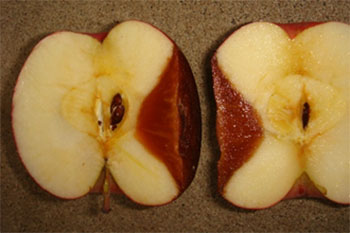
The rot progresses to the core of the fruit in a V-shaped pattern and has a bitter smell. Photo: E. Wahle
Fruit infection can occur early, but is more common from mid to late season. The rot usually begins as a small, light brown, circular lesion that may be surrounded by a red halo. The lesion takes on a sunken saucer-like shape as it enlarges and fungal structures are produced in concentric rings around the point of infection. These fungal structures called "acervuli" produce large masses of spores that look somewhat crystalline in dry conditions or a creamy salmon-pink under humid conditions. Underneath the visible surface lesion, the rot progresses to the core of the fruit in a v-shaped pattern and has a bitter smell. Over time, multiple lesions coalesce and the spore masses will age to a dark-brown to black color, eventually resulting in a mummified fruit.
The bitter rot fungus overwinters in mummified fruit (from disease or hanging thinned fruit), in cracks and crevices in bark, and in cankers produced by other diseases such as fire blight (and more rarely in cankers produced by bitter rot). According to David Rosenberger, Plant Pathologist and Professor Emeritus, Cornell University, inoculum can also overwinter on prunings left beneath trees, rotted fruit left on the ground and from one of many wild hosts in hedgerows and woodlots (he gave the example of horse-chestnut, Aesculus hippocastanum). As a result, sanitation is critical in reducing fungal inoculum...dead wood, including the current year's fire blight strikes, needs to be removed from the tree and destroyed. All mummies hanging on the tree and rotted fruit from under the trees after harvest must be removed. If practical, remove diseased fruit from the tree during the growing season to reduce the spread of the disease.
In 2015, David Rosenberger presented data that showed bitter rot and black rot were more prevalent on Honeycrisp than on other cultivars and that none of the fungicide treatments were very effective. In his 2011 trial, even the best treatment had only 60% of Honeycrisp fruit free of decay by August 23. Why? His hypotheses that awaits testing is that localized heat stress may inactivate host defense mechanisms in the fruit, allowing initial bitter rot infections. Then later, the secondary infections don't require the same heat stress, due to high inoculum levels generated by initial infections.
|
|
In addition to the sanitation recommendations above, Rosenberger also suggest orchardists consider the following options for reducing heat stress: irrigating to soil saturation ahead of heat waves if possible; possibly applying fresh fungicide ahead of predicted heat; avoiding calcium sprays just prior to predicted periods of high temperatures (>90°F); and finally to consider methods of reducing heat stress like overhead cooling (misting), reflective coatings (Surround, purshade) or hail nets.
Captan is still the best fungicide for protection against bitter rot according to Rosenberger, but if fruit begins to develop lesions, he advises orchardist to use full label rates applied at 10-14 day intervals, especially ahead of warm wet weather. He considers Flint, Pristine and Merivon to be moderately effective, but they all have less visible residue than high-rate captan and should be applied with mid-rates of captan under high disease pressure.
Elizabeth Wahle (618-344-4230; wahle@illinois.edu)
Apple Bitter Rot in Illinois Orchards in 2016
Severe bitter rot occurred in some apple orchards in Illinois in 2016. Apple cultivars Empire, Jonathan, Golden Delicious, and Honeycrisp had 20 to > 90% yield losses. In one site in western Illinois, total fruit loss occurred. Both bitter rot and white rot are common diseases of apples in Illinois.
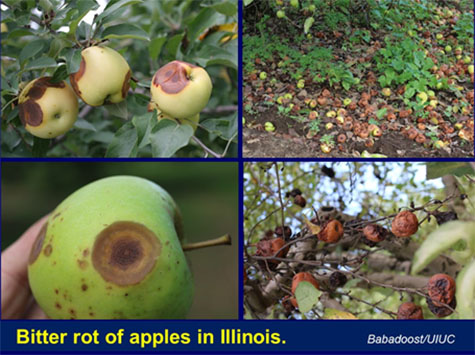
Bitter rot, caused by Colletotrichum gloeosporioides and C. acutatum, is an important summer rot disease of apples and pears in Illinois and other apple and pear growing areas. Glomerella cingulata is the sexual stage of C. gloeosporioides. Colletotrichum spp. also cause a leaf spot and canker.
Fruit infections can occur soon after bloom. Fruit rot symptoms differ, depending on whether infection is initiated by ascospores from the sexual stage (Glomerella cingulata) or conidia of C. gloeosporioides and C. acutatum. Initial symptoms produced by either strain are similar.
The rot begins as a small, light brown, circular lesion. On mature fruit, lesions may be surrounded by red halos. Lesions caused by C. gloeosporioides and C. acutatum remain circular and become sunken as they enlarge. When lesions reach about one inch (25 mm) in diameter, fruiting bodies of the fungus appear near the center of the lesion. Conidia are produced in acervuli, which occur in concentric circles around the point of infection.
Lesions initiated by ascospores of G. cingulata are usually not sunken and are often darker brown than those caused by C. gloeosporioides and C. acutatum. Acervuli are widely scattered over the surface, and perithecia (sexual reproduction bodies) are found in dark brown to clack clumps scattered on the surface of lesions.
Lesions of bitter rot extend in a cone shape toward the core. In cross section, the lesion appears V-shaped. This is a reliable characteristic that can be used to distinguish bitter rot from white rot. The rotten area is brown but much firmer than areas affected by white rot. The number of lesions per fruit may vary from one to many. Infected fruit mummify, and some may remain attached to the tree through the winter.
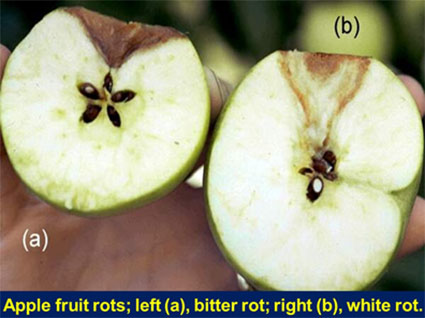
The bitter rot fungi survive the winter in dead wood and mummified fruit that remain on the tree. Other inoculum sources include stems of fruit that were torn from them at harvest or fruit mummified by chemical thinners. Conidia produced in these overwintering sites are the primary inoculum source in the spring, although ascospore inoculum is important in some orchards. Conidia are spread primarily by rain. Ascospores are released by rain and are airborne. Fruit are susceptible from three weeks after petal fall until harvest. Temperature of 80 to 90ºF are most favorable for disease development. Epidemics occur during prolonged periods of wet warm weather. Fruit infection can occur anytime (from soon after petal fall through harvest), but most infection occurs in the latter half of the season. Because of the large number of conidia produced in lesions on fruit and the short disease cycle, spread of the disease within the orchard can be very rapid.
Bitter rot is management by cultural practices and fungicide applications. Removing mummified fruit, dead wood and fire-blighted twigs is important to help manage the disease. Removing diseased fruit from the tree during the growing season reduces the spread of the disease. Fungicides applied from first cover until harvest on a 10- to 14-day schedule are effective if a good sanitation program is followed. If periods of warm, wet weather occur, it is imperative to spray more frequently than every 14 days. Although apple cultivars do not vary widely in their susceptibility, the disease is often more severe on cultivars 'Empire', 'Freedom', 'Golden Delicious', 'Fuji', 'Granny Smith', and 'Arkansas Black'. Fungicides Captan, Flint, Luna Sensation, Merivan, Pristine, and Sovran are effective for control of bitter rot of apples. These fungicides are also effective against black rot, white rot, sooty blotch, and flyspeck diseases. For efficacy of fungicides against bitter rot and other diseases of apples, refer to the "Midwest Fruit Pest Management Guide" (https://ag.purdue.edu/hla/Hort/Documents/ID-465.pdf).
Mohammad Babadoost (217-333-1523; babadoos@illinois.edu)
Less Seriously ...
A few older couples would meet together to talk about life and to have a good time. One day one of the men, Harry, started talking about this fantastic restaurant he went to the other night with his wife. "Really?", one of the men said, "what's it called?" After thinking for a few seconds Harry said, "What are those good smelling flowers called again?" "Do you mean a rose?" the first man questioned. "Yes that's it," he exclaimed. Looking over at his wife he said, "Rose, what's that restaurant we went to the other night?"
John was starving!! He was stuck in a small hick town, lost and hungry. He was happy when he saw a small restaurant coming up on his right. John quickly pulled over, parked his car, and walked inside. John noticed a blackboard with a sign written in yellow chalk, "Today's Special: Vegetable Soup with Fried Chicken and Grilled Vegetables." "I'll take the special", said John to the waiter when he came to take his order. A few minutes after receiving his order John called over the waiter, he was fuming mad. "IS THIS THE SPECIAL!? It says vegetable soup, BUT THERE ARE NO VEGETABLES! It says grilled vegetables, BUT THEY AREN'T GRILLED THEY ARE BAKED!? And it says fried chicken, AND THE CHICKEN ISN'T FRIED!? The waiter was not used to city folks and their attitudes and frankly he was not going to put up with this behavior. "My dear man," said the waiter looking down at John over his glasses, "that is what makes it so special!!!"
Two snowmen are standing next to each other in a yard.
One says to the other, "Funny, I smell carrots too."
--www.greatcleanjokes.com
University of Illinois Extension Specialists in Fruit and Vegetable Production & Pest Management
Extension Educators – Local Food Systems and Small Farms |
||
Bronwyn Aly, Gallatin, Hamilton, Hardin, Pope, Saline, and White counties |
618-382-2662 |
|
Katie Bell, Franklin, Jackson, Perry, Randolph, & Williamson counties |
618-687-1727 |
|
Sarah Farley, Lake & McHenry counties |
847-223-8627 |
|
Nick Frillman, Woodford, Livingston, & McLean counties |
309-663-8306 |
|
Laurie George, Bond, Clinton, Jefferson, Marion, & Washington counties |
618-548-1446 |
|
Zachary Grant, Cook County | 708-679-6889 | |
Doug Gucker, DeWitt, Macon, and Piatt counties |
217-877-6042 |
|
Erin Harper, Champaign, Ford, Iroquois, and Vermillion counties |
217-333-7672 |
|
Grace Margherio, Jackie Joyner-Kersee Center, St. Clair County |
217-244-3547 |
|
Grant McCarty, Jo Daviess, Stephenson, and Winnebago counties |
815-235-4125 |
|
Katie Parker, Adams, Brown, Hancock, Pike and Schuyler counties |
217-223-8380 |
|
Kathryn Pereira, Cook County |
773-233-2900 |
|
James Theuri, Grundy, Kankakee, and Will counties |
815-933-8337 |
|
Extension Educators – Horticulture |
||
Chris Enroth, Henderson, Knox, McDonough, and Warren counties |
309-837-3939 |
|
Richard Hentschel, DuPage, Kane, and Kendall counties |
630-584-6166 |
|
Andrew Holsinger, Christian, Jersey, Macoupin, & Montgomery counties |
217-532-3941 |
|
Extension Educators - Commercial Agriculture |
||
Elizabeth Wahle, Fruit & Vegetable Production |
618-344-4230 |
|
Nathan Johanning, Madison, Monroe & St. Clair counties |
618-939-3434 |
|
Campus-based Extension Specialists |
||
Kacie Athey, Entomology |
217-244-9916 |
|
Mohammad Babadoost, Plant Pathology |
217-333-1523 |
|

